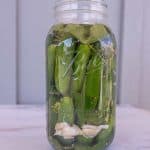Easy Fermented Pickles Recipe
Transform ordinary cucumbers into probiotic powerhouses with this time-tested fermented pickles recipe. Whether you're harvesting from your backyard garden or supporting local farmers at the market, this preservation method lets you enjoy the bounty of summer all year long.
Servings: 1 /2 gallon of pickles
Ingredients
- 4 tablespoons sea salt
- 6 cups chlorine-free water*
- 5 or 6 grape, oak, horseradish, or bay leaves (see notes)
- 8 cloves of garlic
- 2 large heads of fresh or dried dill, or 1 heaping tablespoon dill seeds
- 1 teaspoon black peppercorns
- 1 teaspoon mustard seeds
- ½ teaspoon red pepper flakes optional
- Enough small cucumbers to fill a half-gallon jar (about a pound)
- Round stone to use as a weight that fits in the jar or a fermenting lid kit
- 1/2 gallon glass canning jar or 2 wide mouth quart glass canning jars (instructions below are for using a 1/2 gallon jar, if you use 2 quart jars then split the ingredients equally between the two jars)
Instructions
- Make a brine by adding the sea salt to the water and stirring to combine. Stir until the salt dissolves into the water.
- Add 2 of the leaves to the bottom of the clean glass jar.
- Add half of the garlic, half of the dill, half of the peppercorns, half of the mustard seeds, and half the red pepper flakes (if using), to the bottom of the jar.
- Add half of the cucumbers to the jar. I like to pack them in nicely but not so tightly that they are going to bruise each other.
- Add 2 leaves on top of the cucumbers.
- Add the second half of the garlic, dill, peppercorns, mustard seeds, and red pepper flakes (if using) to the 1/2 gallon jar.
- Add the remaining half of the cucumbers to the 1/2 gallon jar.
- Fill the jar with brine so that it covers the cucumbers and comes about an inch from the top of the jar.
- Add the last leaf to the top of the jar and press it down and around the cucumbers so that it helps to cover them in the brine.
- Wash your stone well and place it on top of the leaf. The purpose is to help weigh down the cucumbers and leaf so that all of the cucumbers, leaf, and rock are kept under the brine. You can also use a brining cap for your jar. I have a Kraut Source lid and love it. If you use a rock make sure that it is fully submersed or it will grow mold.
- If you are using a stone, cover the top of the jar with a cloth and screw or tie something around the cloth (like a canning ring or a rubber band) to keep the cloth in place. This will help to prevent flies and dust from getting in your pickles.
- Place the prepared cucumbers in an out-of-the-way place, out of direct light.
- After a few days the brine will get a little cloudy and you’ll see a few bubbles starting to form on or around things in the jar. This is a great sign that the cucumbers are turning into pickles.
- Taste your pickles after 5-10 days. If you’d like them more sour continue letting them sit for up to 4 weeks, tasting as you go along, until desired sourness is achieved. Once the pickles taste to your liking place them covered in your fridge or in cold storage for long term storage. They can stay in your fridge for up to a year.
Notes
- The brine is full of healthy bacteria as well as the pickles. I like to use it in salad dressings, marinate pork and chicken in it, or splash a little in potato or tuna salad.
- The leaves that are listed contain tannins which help to keep the pickles crisp! The top leaf is also being used as a fermentation “cap” meaning it keeps what you are eating under the brine. If you are going to make pickles when grape leaves are not in season, you can pick the grape leaves and let them dry to have on hand for winter fermenting.
- Be sure to use leaves that have not been treated or sprayed with anything. You can skip the leaves all together if you don’t have them, though I do like the crisp pickles better.
- The salt brine is great at keeping things from molding. That being said, if you see mold on or in your pickles you’ll need to throw them out.
Nutrition
Serving: 1 half gallon of pickles | Calories: 139kcal | Carbohydrates: 26g | Protein: 7g | Fat: 3g | Saturated Fat: 0.3g | Polyunsaturated Fat: 1g | Monounsaturated Fat: 1g | Sodium: 27938mg | Potassium: 897mg | Fiber: 7g | Sugar: 7g | Vitamin A: 654IU | Vitamin C: 24mg | Calcium: 255mg | Iron: 4mg
QR code
Scan this QR code with your phone's camera to view this recipe on your mobile device.
